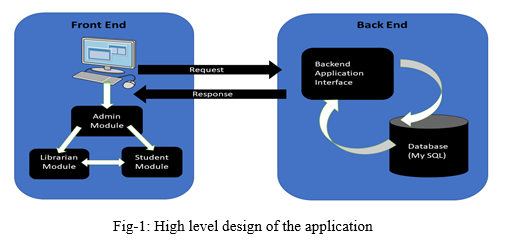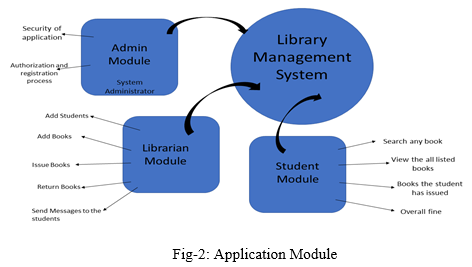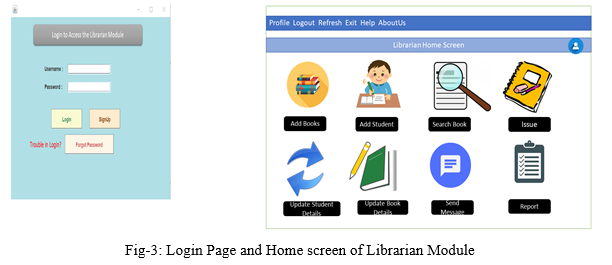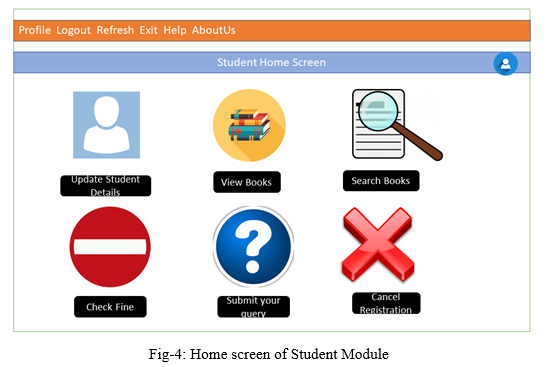Ijraset Journal For Research in Applied Science and Engineering Technology
- Home / Ijraset
- On This Page
- Abstract
- Introduction
- Conclusion
- References
- Copyright
Library Management System
Authors: Sourabh Sharma, Sunny Mishra, Shubham Gupta, Sachin Kumar
DOI Link: https://doi.org/10.22214/ijraset.2022.42375
Certificate: View Certificate
Abstract
A Library Management System is a project that tries to create an automated and computerised version for a library so that the daily work of a library can be managed and monitored easily and efficiently. Earlier, the librarian used to manage the whole work in manual mode in the form of files and record books. Also, the process of adding new books, new students, issuing and returning books had to be managed in a manual manner which is very slow and inefficient. The library management system resolves this problem and provide a better solution to this. It provides a user-friendly interface application to the librarian where he can do all the operations of a library very easily. The application mainly consists of three modules which are admin module, librarian module and student module. The admin module will be managed by the system administrator. He manages the overall functioning of the application. The librarian module will be accessed by the librarian. He can perform various operations inside the application such as add new students, new books to the database, issuing and returning of books, updating student’s details, book’s details, generating weekly/monthly reports etc. The student module can be accessed by the registered students only. The operations that can be performed by the student includes: view all books available in the library, search the availability of a particular book, number of books he has issued, overall fine he has to pay etc. These three modules are interconnected with each other and also with the database. The application is built using Java technology and Sql database.
Introduction
I. INTRODUCTION
Traditionally, the librarian managed the whole work in a manual mode or recording the work details in a record book. He has to manage all the work related to library such as issuing books to the students, returning books from the students, maintaining all the details of the books, adding new students, new books etc. on a daily basis. But with the increase in the number of user/students and number of books in a library, this management process has become slow and complex. So, a better management of the library work is required.
The purpose of the library management system is to automate and digitize this traditional way of managing the library work. The Library Management System is much more user-friendly, faster in operation and easy to manage than the manual one. Through the use of it, the librarian can manage the whole data of the library in a single database in different tables with a much more security than the traditional way. In a library, tasks like issue/return/add new students/add new books/ checking any discrepancy in stock, calculating fine for overdue books etc. are performed on a daily basis and suppose a student asks for a particular book from a librarian then he has to search the book manually which takes a lot of time and there are chances of human error in that process as well. But with the help of LMS, the searching of books has become quite easy and fast and the librarian only needs to enter the book id in the search section of the application. Similarly, if a new student has to be added as a registered member of the library or an existing student has to be removed then this process has become very easy to perform. So, all these kinds of operations can be digitized and performed efficiently by using a library management system.
II. PROPOSED SYSTEM
An online library management system is a practical solution for the existing issues of the traditional library system. It is basically a windows application that is built mainly on Java technology and relational database (sql). The similar application can also be built using the web technologies like HTML, CSS and JavaScript and a corresponding database, that can be a relational database like sql, oracle or no-sql database like mongodb.
Using this application software, the librarian can search any book by using the issued book id of that particular book in just a second. He can also add new students, new books to the library database, can issue books, return books by making the necessary changes to the database part from the application user-interface. The whole application is divided into different section depending upon its usage. The different sections are explained in the architecture part of this paper.
A. Advantage over Traditional System
As we know that the manual process of maintaining the data of a library in files or excel sheets is very hard. An online library management system provides a number of benefits and alternatives to the traditional library workflow.
Following are the advantages of an automated library management system:
- Reduces the library management cost.
- Enhancing monitoring and reporting process.
- Eliminate the paper work and makes the library data more secure.
- Removes the need for manual book distribution and simplifies the procedure to save time and effort. It also makes it simple for librarians to catalogue books and maintain track of those that have been issued, reissued, and not returned.
- It's simple to create a customised report for library items, inventories, and fines.
- Human involvement is still required in this automated system (library management system), but the number of decisions or processes that a human must perform is reduced.
B. Requirements for the Application
- Hardware Requirements: The minimum acceptable hardware requirement that are required for the proper functioning of the application are given below:
a. Operating System: Windows
b. Hard disk and RAM: 40GB and 4GB are required respectively
c. Processor: Dual-Core CPU
2. Software Requirements: In our application, various supporting software’s, libraries and tools are required which will help to develop this application. These software and libraries can be easily downloaded through the internet and then can be integrated with the application. The required software’s requirement is listed below:
a. Windows Web Development Environment: The Windows Web Development that we are using in our project is WAMP server. This WAMP server is responsible for connecting the database to our LMS application. Various databases that are supported in the WAMP server are MySQL, Oracle and Php.
b. Drivers and Libraries: JDBC drivers which stands for “Java Database Connectivity” are also required. It basically helps to connect our java application with our SQL database. A sql library, often known as a sql connector library, is also required in our application. The sql library comes in a file with a (.jar) extension.
c. C++ Redistributable Packages: The Visual C++ Redistributable is a DLL (Dynamic Link Library) file required by many applications or programs to function correctly. The majority of these Visual C++ redistributable files and runtime packages are installed for standard libraries that are used by many software applications. So, if your program relies on such libraries and runtime packages, you must first install them before proceeding further. Otherwise, you will face difficulties during runtime and execution.
d. Java Packages: The main packages that we are using in our project are SWING and AWT (Abstract Window Toolkit). Swing makes it possible to create input methods through its interface that work in any java runtime environment. It provides a set of lightweight components that work across all platforms to the greatest extent possible and the Java AWT is an API that contains large number of classes and methods to create and manage graphical user interface (GUI) applications.
III. ARCHITECTURE
As we know, any software application consists of broadly three parts: Front-End, Back-End and a Database part. This application also has these three parts.
The front-end part helps the admin and librarian to interact with the database.
4The front-end part is further divided in to three different sections or application modules. Those application modules are Admin Module, Librarian Module and Student Module. These modules can be accessed by the administrator, librarian and students by interacting with the front-end screens of the application respectively. The modules are internally connected with the backend portion and the database.

A. Application Module
The whole software application is divided in to three modules which are Admin Module, Librarian Module and Student Module.
These three sections are accessible through the application's three different panels, making it user-friendly. The modules are interconnected with each other so that they can communicate the information between them. For example, admin module is connected to the librarian module and only those people can access the librarian module which are authorised by the administrator under the admin module. Similarly, the students will be able to access the student module only if they are registered in the library database by the librarian.

- Admin Module: The programme administrator will be in charge of the admin module. He is the one in charge of the application's security and authorization. Only the admin can register the different librarians with the application and the database. The librarians can only access the application if they are authorised and registered. He has full access to the whole application and manages the overall functioning of the software. If somebody has a problem with anything, they should first contact the administrator.
- Librarian Module: The librarian has full access to the librarian module. So, whenever a librarian opens the application, he has to login in the application with the user id and password provided by the admin. The various actions that he can undertake are visible on the home screen after a successful login. The operations he can perform includes: add new students, add new books, issue books, return books, updating student’s details, updating book’s details, sending messages to the students regarding various issues (like overdue of the issue book), generating weekly/monthly reports, monitoring any discrepancy in the books stock.
- Student Module: The student module contains details about all the students registered with the library. Only the librarian can register the students with the application after successful verification. The operations that student can perform inside the student module includes: view all books available in the library, search the availability of a particular book, number of books he has issued from the library, overall fine that he has to pay, submit the queries. Apart from this, the students can cancel their registration from the library.
IV. RESULTS AND OUTPUTS
When the librarian opens the application, a login page will come on the screen. After successful login by the librarian, a home screen will come in front of it where he can do all the operations. He can go to different sections on the home screen to perform various operations.

The below image shows the home screen of the student module. The students can login in to the application and then a home screen will come in front of the him. He can perform all those operations that are listed below in the student module.

V. FUTURE SCOPE
In the future, many more features and facilities can be added to the application. As we know with the increase in number of students, books, complexity other workloads, there can be a need of shifting the library data from the local database to the cloud. So, this software application can be transferred to a cloud database by doing necessary changes to it. With the help of cloud technology, you will get data backup facility, remotely updating and syncing of files, more security of data, lifetime storage etc. Online lectures, previous year examination papers, videos and an assignment submission section are all possible additions. Teachers can shoot the videos of their lectures and upload them on it. A group chat function might be included to the app so that students can share their concerns and doubts which will ultimately makes it more interactive and useful for an academic institution.
Conclusion
This paper mainly focuses on how we can improve the traditional method of working of a library because the traditional method includes doing all the things in manual mode which is slow, less efficient, less secure, and difficult to manage. The solution to this is an online library management system which take care of all the work by automating and digitizing the whole process. Our application is based on Java and is linked to a relational database (sql). The frontend part has been coded using Java and its packages like awt and swing. The backend is supported and connected with database using java, its libraries and APIs. With the increase in the workload of the library, new features can be added to the existing application to make it relevant in the future as well.
References
[1] Jason McHugh, Serge Abiteboul, Roy Goldman, Dallan Quass, Jennifer Widom, Lore: A Database Management System for Semistructured Data, Sigmod Record, Volume 26, No. 3, September 1997. [2] Omkar Sunar Verma, Ishwar Chaudhary, Mahammad Javed khan, Akhilesh Kumar Chaudhary, Isha, A comparative study of relational database management system and object oriented database management system, International Journal of Creative Research Thoughts, Volume 9, Issue 4, April 2021, ISSN: 2320 – 2882. [3] Kreucher, C.; Lakshmanan, S., 1999. A frequency domain approach to lane detection in roadway Image Processing. International Conference on ICIP 99, Volume: 2, 24-28 Oct.1999. Pp 31 -35 Muhammad B. A. and Tae-Sun C., 1999. Local Threshold and Boolean Function Based Edge Detection, IEEE Transactions on Consumer Electronics, Vol. 45, No 3 gfrdsgs Muhammad B. A. and Tae-Sun C., 1999. Local Threshold and Boolean Function Based Edge Detection, IEEE Transactions on Consumer Electronics, Vol. 45, No 3 [4] Vishesh S, Kavya P Hathwar, Ranjan Ravishanka, Nandhishwara BN, Hema R, Amulya HP, Back-End Web-Application Development and the Role of an Admin, International Journal of Advanced Research in Computer and Communication Engineering, Volume 6, Issue 9, September 2017. [5] Rachida F. Parks, Chelsea A. Hall, Front-End and Back-End Database Design and Development: Scholar’s Academy Case Study, Information Systems Education Journal (ISEDJ), Volume 14, Issue 2, March 2016, ISSN: 1545-679X. [6] Prof. B.A. Jadhawar, Komal A. Bhosale, Research Paper on Java Interactional Development Environment Programming Tool, International Advanced Research Journal in Science, Engineering and Technology, Volume 4, Special Issue 4, January 2017. [7] Dewi AR, Avinanta T, Egy WM, Fitria HS & Sigit W, The Use of Java Swing’s Components to Develop a Widget, International Journal of Human Computer Interaction (IJHCI), Volume 2, Issue 4. [8] Murtagh T. P, Programming with Java, Swing and Squint, Williams College, 2007.
Copyright
Copyright © 2024 Sourabh Sharma, Sunny Mishra, Shubham Gupta, Sachin Kumar. This is an open access article distributed under the Creative Commons Attribution License, which permits unrestricted use, distribution, and reproduction in any medium, provided the original work is properly cited.

Download Paper
Paper Id : IJRASET42375
Publish Date : 2022-05-08
ISSN : 2321-9653
Publisher Name : IJRASET
DOI Link : Click Here
 Submit Paper Online
Submit Paper Online

